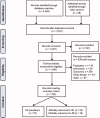The effect of hyperkalemia and long inter-dialytic interval on morbidity and mortality in patients receiving hemodialysis: a systematic review
- PMID: 33478329
- PMCID: PMC7833048
- DOI: 10.1080/0886022X.2020.1871012
The effect of hyperkalemia and long inter-dialytic interval on morbidity and mortality in patients receiving hemodialysis: a systematic review
Abstract
Background: Patients with chronic kidney disease, especially those receiving hemodialysis (HD), are at risk of hyperkalemia (HK). This systematic review aimed to evaluate the prevalence of HK in patients with renal disease receiving HD and collate evidence on the effect of HK and differing HD patterns (i.e., long vs. short inter-dialytic intervals [LIDI and SIDI, respectively] in a thrice weekly schedule) on mortality.
Methods: Comprehensive searches were conducted across six databases and selected conference proceedings by two independent reviewers up to September 2020. A hundred and two studies reporting frequency of HK, mortality, or cardiovascular (CV) outcomes in adult patients with acute, chronic or end-stage renal disease in receipt of HD were included. Narrative synthesis of results was undertaken with key findings presented in tables and figures.
Results: Median prevalence of HK in patients with renal disease receiving HD was 21.6% and increased in patients receiving concomitant medications - mainly renin-angiotensin-aldosterone system inhibitors and potassium-sparing diuretics. Associations between elevated potassium levels and increased risk of both all-cause and CV mortality in the HD population were consistent across the included studies. In addition, there was a rise in all-cause and CV mortality on the day following LIDI compared with the day after the two SIDIs in patients on HD.
Conclusions: Evidence identified in this systematic review indicates a relationship between HK and LIDI with mortality in patients with renal disease receiving HD, emphasizing the need for effective monitoring and management to control potassium levels both in emergency and chronic HD settings.
Keywords: Hyperkalemia; hemodialysis; long inter-dialytic interval; renal disease; systematic review.
Conflict of interest statement
DB, DS, BW, IZ, KB, DB and PM are employees of Health Economics and Outcomes Research Ltd and received funding from AstraZeneca to undertake the research outlined in this study. ET is an employee of AstraZeneca. The results presented in this paper have not been published previously in whole or part, except in abstract format.
Figures



References
-
- Viera AJ, Wouk N.. Potassium disorders: hypokalemia and hyperkalemia. Am Fam Physician. 2015;92:487–495. - PubMed
-
- Soar J, Perkins G, Abbas G, al. e. European Resuscitation Council Guidelines for Resuscitation 2010 Section 8. Cardiac arrest in special circumstances: electrolyte abnormalities, poisoning, drowning, accidental hypothermia, hyperthermia, asthma, anaphylaxis, cardiac surgery, trauma, pregnancy, electrocution. Resuscitation. 2010;81:1400–1433. - PubMed
-
- Tran HA. Extreme hyperkalemia. South Med J. 2005;98:729–732. - PubMed
-
- Spodick DH. Effects of severe hyperkalemia. Am Heart Hosp J. 2008;6:68. - PubMed
Publication types
MeSH terms
Substances
LinkOut - more resources
Full Text Sources
Other Literature Sources
Medical
